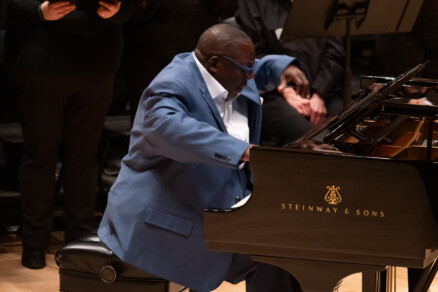The best D.C. jazz albums of 2022 (so far)

Summer is drawing to a close, and the fall arts season is nearly upon us. So, as concerts blossom across the city, we thought this would be a good moment to shine a light on all the great recorded music that has come out this year from D.C.-area jazz musicians. Most of these artists are easy to find onstage; we recommend checking out these albums, and then seeking out the artists you like when they next play live — which is, after all, the setting where this music always flourishes best.
While we still have not seen a total end to the COVID-19 pandemic, D.C. jazz musicians continue to be notably prolific — continuing to confirm that our city is a beacon of musical excellence and emotional uplift.
A large team of CapitalBop contributors (including some fresh voices we’re excited to welcome) was tasked with writing about these recent albums. There’s great range in the list below — from traditional jazz vocalese to extended works of improvised percussion — reflecting the breadth of the jazz and creative music traditions in our region. Happy reading, and happy listening! —Jackson Sinnenberg, CapitalBop listings editor
Janel Leppin, ‘Ensemble Volcanic Ash‘
review by Abe Mamet
Janel Leppin has, blessedly and finally, allowed her 10-year-old musical project Ensemble Volcanic Ash to take recorded wings and fly into the universe. Featuring harpist Kim Sator, saxophonists Brian Settles and Sarah Hughes, bassist Luke Stewart, guitarist Anthony Pirog, drummer Larry Ferguson and Leppin on cello and keyboards, Ensemble Volcanic Ash has, thus far, been a D.C.-specific institution whose music could only be experienced live, usually within the confines of the city. Now, with the release of her group’s self-titled debut — which is already getting wide attention — Leppin delivers a potent dose of beauty to a world in desperate need of it. Her medicine is as boundless and rewarding as ever.
This is an omnivore’s recording that flutters between definitional boundaries. Ensemble Volcanic Ash will fit neatly into any number of music libraries, whether focused on jazz, punk, spiritual music, various forms of classical music, or the rewarding spaces in between those traditions. The music itself is exquisite. Each listen uncovers delicious new experiences, whether through the blast of Pirog and Leppin’s ripping interplay on “She Had Synesthesia,” the spine-tingling opening chords of “I Pose,” or one of the rare and precious moments throughout the record when Sator’s harp is exposed and leading the band.
This artwork is truly the sum of its parts; each song is a world in an infinitely textured universe, and each musician is a vibrant thread sewn within an expertly crafted weaving.
Nik Francis ‘Consensus Dimension‘
review by Tommy Gartman
Nik Francis’ Bandcamp page for Consensus Dimension urges: “headphones are recommended!!!” I’m glad I took that advice – you will be too.
Francis’ new album is a solo work for percussion, created by layering three improvised recording sessions — featuring gongs, bells, modified drums, and other instruments — over one another. The 30-minute, continuous piece begins jarringly, building into what sounds like a cross between free jazz and early industrial music: kind of like if Sunny Murray met Z’EV and you threw in some chimes, and slowed it all down to half tempo. Trepidation on the part of the listener, however, soon evaporates into curiosity as certain sounds in the discordance begin to stand out and become contextualized as something known. A few minutes in, you start picking up the sound of a screen door slowly swinging on rusty hinges; next comes metal chair legs raking across a linoleum floor and a church handbell choir, then a foghorn, a deep breath, and a muted exhalation.
What Francis does with Consensus Dimension amounts to an experiment in sound architecture. With only a handful of percussive instruments, he creates a soundscape for listeners to make sense and meaning of, drawing on each individual’s unique library of known sounds. It’s challenging and it’s exciting, and it will leave you thinking about sound in a totally new light.
Heidi Martin, ‘Gifts & Sacrifices‘
review by Jamie Sandel
Heidi Martin’s Gifts & Sacrifices opens with “Memphis,” a song she wrote nearly two decades ago for her debut album, Hide. The Southern Maryland-born vocalist has seen a lot since that release in 2005: a battle with cancer; her city’s accelerating gentrification; her sons becoming young men; and the mainstreaming of both Black liberation and white supremacy in her country. And where Hide’s “Memphis” featured a clean, tight, mostly straightforward arrangement, its 2022 version is an entirely different experience, a musical kaleidoscope of cymbal crashes, trumpet improvisations and brooding keyboard vamps.
Martin’s band, featuring world-renowned players including drummer Eric Harland, pianist Raymond Angry, trumpeter Josh Evans and guitarist Paul Bollenback, helps drive that contrast home, creating musical depth and texture that speak to all that’s happened in the years since her last release, in 2007. But the themes grounding her songwriting remain the same: plain-spoken truths about American racism — delivered in groove-oriented tracks like “African Waltz in a common time” and “Rice” — alongside tender acoustic homages to love and discovery, like “Moon in Scorpio” and “My Father Left Us for the Moon.”
George V. Johnson Jr., ‘Walk Spirit, Talk Spirit‘
review by Leon Spinner
On Walk Spirit Talk Spirit, vocalist George V. Johnson Jr. delivers an ode to the legacy of jazz pianist McCoy Tyner, who passed away in 2020, via a combination of covers of tunes by Tyner and other legends. The eight-song album is a charming body of music, exploring a wide range of vocal jazz, with the versatile singer using almost every phrase in his harmonic vocab to give listeners a complete music experience.
Accompanying Johnson is Allyn Johnson on piano, Herman Burney on bass, Dana J. Hawkins on drums, Elijah Easton on saxophone and Donvonte McCoy on trumpet. The music includes established jazz classics and standards with Johnson’s lyrics and the band’s improvisations added to the mix, resulting in an album of music that’s unique yet very familiar. Johnson mischievously scats, even infusing Herbie Hancock’s “Cantaloupe Island” with an impromptu “Spiderman Theme” verse that may force a quick chuckle — or a rewind, even. He passionately urges listeners to “Come Fly Away with Me” on McCoy Tyner’s composition “Fly with the Wind.” He also delivers a soulful performance on the Lou Donaldson chestnut “All Aboard the Gravy Train” (Burney and Allyn Johnson also offer some outstanding playing here), creating a tune that’s liable to make listeners want to get up and “shake your booty!” Johnson makes every song a standout by showcasing his incredible range and vocal control.
As for the band’s performance, there are more than a few remarkable moments on this album: Hawkins gets busy at the end of “Cantaloupe Island,” breaking away from setting the rhythm to create his own. Easton cuts loose during his opening solo on “Knarrative Will Set Us Free” (an interpretation of Tyner’s “Walk Spirit Talk Spirit”), voicing lyrics with his horn buzzing around while his colleagues keep a steady pace.
The musicians on the record sometimes nearly persuade the listener to forget that Johnson is even present. Still, when his sultry voice reappears after the impressive soloing from the group, it tends to feel as if he never really left.
Todd Marcus, ‘In The Valley‘
review by Jackson Sinnenberg
At the Blues Alley release show for In The Valley, in May of this year, bass clarinetist Todd Marcus talked about a 2018 trip to Egypt that inspired this new album. He spoke of the wonder and amazement he felt cruising along the Nile, entering the city of Luxor and traversing the legendary Valley of the Kings. That sense of wonder is one of the key elements that makes the music on In The Valley so captivating and so immersive.
Recorded with a new lineup of his jazz orchestra – a nonet featuring some of the best players in Baltimore, like alto saxophonist Brent Birckhead, pianist Xavier Davis and drummer Eric Kennedy – the six tracks of In The Valley are arranged in such a way that allows Marcus to really bring us into his perspective. On the title track, the interplay between brass and woodwinds creates a sense of grandiosity, as if one is descending into the Valley of the Kings, feeling the majesty of the tomb-dotted cliff faces rising above you. But then, on “Cairo Street Ride,” Marcus and his orchestra capture the frenetic energy and vibrancy of a journey through the bustling Egyptian capital: from sweeping past leisurely sidestreets to the intensity of market squares, to the symphonic blare of car horns and engines erupting in traffic. Marcus places you in the center of it all, and it is thrilling to be along for the ride.
Luke Stewart’s Silt Trio, ‘The Bottom‘
review by Abe Mamet
Silt brings disparate natural elements together as foundational layers of growth. With his newest record, The Bottom, bassist Luke Stewart uses his Silt Trio to do exactly that, painting a clear, unified image of his artistic past as well as a view into the continued promise of a vivacious future.
The record is a journey in surprise, tenderness and energetic intrigue. Some moments are surprisingly traditional: “Dream House” and “The Bottom,” for example, swing hard, with Stewart and percussionist Chad Taylor laying down grooves that could fit as well in 1962 as they could in 2022. Other moments play more traditionally modern, giving a jolt of heady, abstract group improvisation. “Angles,” in particular, provides peak sonic delight as Stewart’s bass, rather than driving a groove, builds a diverse and bubbling landscape. Slowly that draws in both Taylor and saxophonist Brian Settles for a journey well worth repeating.
Especially beautiful, and indicative of the mastery that these three musicians bring to the date, are the moments where improvisation and composition become difficult to distinguish — a blurriness which seems to matter less and less with each successive listen. (Disclosure: Stewart is also CapitalBop’s co-founder and director of presenting.)
Sarah Hughes/Jon Steele/Nate Scheible, ‘Live @ Jojo’s (Set 1)‘
review by Jordannah Elizabeth
Saxophonist Sarah Hughes was joined by Jon Steele on double bass and Nate Scheible to present a live, improvised body of music at the U Street jazz club Jojo’s in the spring of 2022. Live @ Jojo’s (Set 1) marks the debut of this trio, one that performs with fervor and chemistry, though Hughes is already an accomplished artist in her own right. She leads the band with tapering ornamentation on soprano saxophone; her tonal choices are sweeping and romantic as she shies away from staccato, quick tempered expressions — instead leaving room for Steele and Scheible to accentuate and fill in the spaces between her notes with atmospheric, dreamy accompaniment. The group has natural chemistry and accommodates each other’s styles quite nicely.
This live album is intriguing because of the trio’s intuitive dynamics, and its spacious understanding of Hughes’s playing and band leadership. Neither of the members is driving each other into forward motion, but they tend to stay in the moment and savor what is being played at each turn. This attentiveness comes from an organic sonic evolution making each second an opportunity to listen just as much as they play. The music they produce is sensual and atmospheric. The vibrations within and between each note bellows throughout the venue and there is a pleasing sense of calm and sophistication, a sense of youthfulness combined with seasoned musical wisdom that only comes with musical consciousness and years of experience.
Amy K Bormet, ‘Tell Me What It’s Like‘
review by Levi Dayan
Tell Me What It’s Like finds D.C.-based pianist and vocalist Amy K Bormet presenting original songs with a remarkable level of depth and urgency. This music speaks to a deep and personal sense of intimacy.
These works speak of the heaviness of the past few years, and of letting go of the burdens of day-to-day life to find inner peace. On the title track, using heavenly multi-tracked harmonies reminiscent of the ‘70s singer/songwriter Judee Sill, Bormet beseeches: “Tell me what it’s like to fall, / Tell me what it’s like to fade away.” Meanwhile, the song “Jealous of the Birds” finds a sense of serenity in the apparent aimlessness of birds in flight.
But for all this talk of intimacy, Tell Me What It’s Like is also a remarkably full album, with Bormet’s dynamic vocal range and robust piano work taking up all of the space that it needs. By placing singer/songwriter music firmly in the lineage of jazz’s history of free musical expression, Bormet provides a vital testament to the creative possibilities of vocal music.
–
Lead illustration by Jamie Sandel
DC, DC jazz, George V. Johnson, Janel Leppin, jazz, Luke Stewart, Sarah Hughes, Washington




